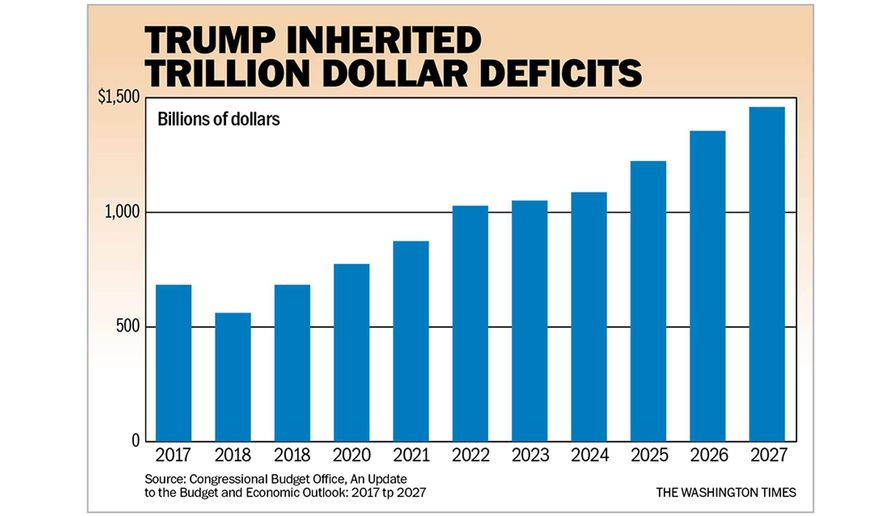OPINION:
There is an old saying that you can’t teach an old dog new tricks, and we’ve learned that again with the Congressional Budget Office and its latest highly misleading fiscal forecast.
For years, we’ve been trying to get the CBO to use real-world scoring that reflects how businesses, workers and financial markets react to changes in tax rates. But no go.
This is why the left is having a field day with the CBO forecast that deficits under President Trump will average a trillion dollars a year for the next decade. This is supposed to be a result of Mr. Trump’s tax cuts, but hold on here. Take a look at the nearby chart. It shows the deficit forecast with and without the tax cuts. They are effectively the same.
Mr. Trump didn’t create $1 trillion deficits, he inherited them from the grand maestro of debt spending, Barack Obama. President Obama invented and then perfected the concept of 13-digit borrowing. His deficits in his first term reached $1.5 trillion — an Olympic record of fiscal recklessness.
Is there anything more hypocritical than liberals, who supported Mr. Obama’s policies that ran the debt from about $11 trillion to almost $20 trillion, now fainting over runaway deficit spending? Yes, Chuck Schumer, there is gambling going on here at this casino.
The CBO says that the deficit will be about $1.5 trillion higher because of policy changes. Almost 40 percent of that is the inexcusable omnibus spending bill — a bipartisan raid of the federal cookie jar.
About $1 trillion of the higher borrowing over 10 years is due to the tax cut. By the way, this is the lowest estimate for the “cost” of the tax cut, we’ve seen. That $1 trillion revenue loss is out of almost $40 trillion of expected revenue. That’s a 2.5 percent tax cut — which is hardly the fire hose of lost revenue that is being depicted.
At the very least we can dispense with the hyper-inflated rhetoric of $3, $4 and $5 trillion debt increases due to the tax cut — that are thrown around in the media from liberal interest groups.
The fantastical claim of the CBO is that the economy will grow by only 1.9 percent annual growth for the next decade. (This is up a smidgeon from its 1.8 percent prediction at the start of the Trump presidency.) To be fair, CBO’s growth estimate is in line with most of the Blue Chip forecasters as well.
That prediction makes no sense. GDP growth averaged 1.95 percent annually under Mr. Obama — and nearly everything he did on the economy was anti-growth.
Now we have a president who is cutting tax rates, chopping down regulations, promoting massive new energy and mineral development, reforming welfare to get people into the workforce, redesigning trade policy to get better deals for American companies and products — and this is going to only give us the measly rate of growth we had under Mr. Obama?
No. The core principle of Trumponomics is to attain at least 3 percent growth. Every policy is focused like a laser beam on that goal. It’s not a shot to the moon. The average growth rate of the U.S. economy for the past century is about 3.3 percent.
In a recent economic analysis, Rob Arnott, founder of Research Affiliates, and I recalculated the CBO numbers and plugged in 3 percent growth, not 1.9 percent growth.
Guess what? The debt to GDP ratio goes down, down, down every year. Instead of a horrific debt to GDP ratio of 150 percent in 20 years, that ratio actually falls to about 50 percent — very managable.
With long-term growth of GDP of 3 percent all the entitlement deficits begin to disappear as well. This is because tax revenues overwhelm spending over time with 3 percent GDP growth. It’s called the power of compound interest.
The point here is that CBO’s creaky computer models begin with the firm conviction that Trumponomics won’t work and then surprise, it cranks out a conclusion that Mr. Trump’s policies won’t work. This is what passes for rigorous analysis these days.
Welcome to la la land.
• Stephen Moore, a columnist for The Washington Times, is a senior fellow at the Heritage Foundation and an economic consultant with FreedomWorks. He served as a senior economic advisor to the Trump campaign.




Please read our comment policy before commenting.